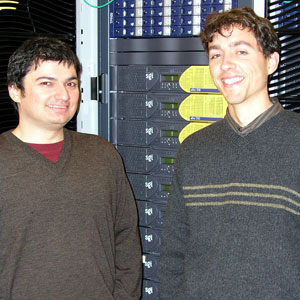It may have been one of the most interesting grant applications ever written. Two Dalhousie researchers wanted to purchase high-powered computer equipment to further their research, yet their names will probably never appear together on any paper or project.
In fact, Randall Martin and Jordan Kyriakidis, both Assistant Professors in the Department of Physics and Atmospheric Science, study completely different things. But, in an unusual collaboration, the two made a successful bid to get a cluster of four powerful SGI Altix 350 computers, installed in the summer of 2004. According to Kyriakidis, there are only a handful of computers this powerful in Canada right now.
 | ||
| Although researching two very different subjects, Jordan Kyriakidis (left) and Randall Martin began collaborating even before Martin arrived at Dalhousie, to acquire this cluster of SGI Altix computers. | ||
Martin is using two computers to model the movement of pollutants throughout the atmosphere, while Kyriakidis is exploring the world of quantum nanoelectronics, toward the development of quantum computers. "It was an interesting grant proposal that we wrote," Kyriakidis remarks. "We had to write one application, so we had one application on both global climate modelling and quantum nanoelectronics!"
The collaboration between these two young researchers began when Kyriakidis, new to Dalhousie just over two years ago, started thinking about the kind of computer he needed for research. Aware that new faculty members would be joining the department, he began contacting them to find out if any had similar needs, to pool resources and get more computing bang for their bucks. This lead to a partnership six months before Martin arrived at Dalhousie.
Using two of the four computers, Martin can now work easily with the GEOS-CHEM model he helped develop during his PhD at Harvard. "It's a state of the art model that divides the atmosphere into about a million boxes, and solves for the chemical evolution of different pollutants as they're transported around the atmosphere," says Martin.
The model is used in combination with tremendous volumes of meteorological, NASA and European Space Agency satellite data, all stored easily in a three terabyte hard drive (about 30 times larger than the average home computer hard drive). "I can take observed fields and use the model to work backwards chemically, and in time, to infer what pollutants have been emitted," Martin explains. "These computers enable what I do. Without them, I couldn't run my own simulations, or use current satellite data." In the future, he sees his research being used to enforce international environmental regulations like the Kyoto Protocol.
Kyriakidis' research is part of the quest to develop quantum computers. "The quantum world is the interface between the microscopic and macroscopic," he explains. "Right now, computers are based on bits of binary code that can be zero or one. Once you get down to the quantum level, these distinctions don't hold. Things can be in two states at once. The bit could be 0 and 1 at the same time." Because of this, quantum computers have the potential to be millions of times more powerful than today's supercomputers.
But, working with today's supercomputers is what allows Kyriakidis to simulate quantum computing. His half of the computer cluster includes 32 processors that "talk" to each other in real time as they're doing different calculations. "This really simulates what could happen in a quantum system," he says. "In quantum systems, the interaction between different components is very important, so this allows us to figure out the kind of interactions that might occur." Although they won't be working together on any projects in the future, Kyriakidis and Martin agree their unusual partnership has netted great benefits for both. Support for the purchase of these computers was provided by the Canada Foundation for Innovation's New Opportunities Grant, the Nova Scotia Research and Innovation Trust, and Silicon Graphics, Inc.
